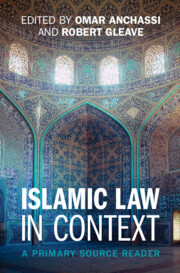Book contents
- Islamic Law in Context
- Islamic Law in Context
- Copyright page
- Contents
- Acknowledgements
- Contributors
- Introduction
- Part I Islamic Legal Theory (Uṣūl al-Fiqh) and Related Genres
- Part II Islamic Jurisprudence (Fiqh) and Related Genres
- Chapter 7 Introduction to Part II
- Chapter 8 The Kitāb al-Umma, or Ṣaḥīfat al-Madīna
- Chapter 9 Section on Lawful Food from al-Mabsūṭ fī Fiqh al-Imāmiyya of Muḥammad b. al-Ḥasan al-Ṭūsī (d. 460/1067)
- Chapter 10 ‘The Treatise of Refutation of those who Criticise [Our] Conduct’ (Kitāb al-Radd ʿalā man Ṭaʿana fī l-Sīra) Attributed to Imām al-Mutawakkil ʿalā Allāh, Aḥmad b. Sulaymān (d. 566/1170)
- Chapter 11 Menstruating Women and Visiting the Mosque
- Chapter 12 Section on the Law of Rebellion from the Radd al-Muḥtār of Ibn ʿĀbidīn (d. 1252/1836)
- Chapter 13 Offer and Acceptance in Islamic Marriage
- Chapter 14 Treatise on Jihad and Migration
- Chapter 15 Alms Tax (Zakāt) in Shīʿī Law
- Chapter 16 A Difficult Case of Divorce
- Part III Legal Opinions (Fatwās)
- Part IV Court Judgments and Other Court Documentation
- Part V Judicial Manuals and Reference Books
- Part VI Alternative Sources for Islamic Legal Studies
- Name Index
- Subject Index
- References
Chapter 15 - Alms Tax (Zakāt) in Shīʿī Law
Selections from the Jāmiʿ al-Shatāt of Nuṣrat Amīn (d. 1403/1983)
from Part II - Islamic Jurisprudence (Fiqh) and Related Genres
Published online by Cambridge University Press: 14 November 2024
- Islamic Law in Context
- Islamic Law in Context
- Copyright page
- Contents
- Acknowledgements
- Contributors
- Introduction
- Part I Islamic Legal Theory (Uṣūl al-Fiqh) and Related Genres
- Part II Islamic Jurisprudence (Fiqh) and Related Genres
- Chapter 7 Introduction to Part II
- Chapter 8 The Kitāb al-Umma, or Ṣaḥīfat al-Madīna
- Chapter 9 Section on Lawful Food from al-Mabsūṭ fī Fiqh al-Imāmiyya of Muḥammad b. al-Ḥasan al-Ṭūsī (d. 460/1067)
- Chapter 10 ‘The Treatise of Refutation of those who Criticise [Our] Conduct’ (Kitāb al-Radd ʿalā man Ṭaʿana fī l-Sīra) Attributed to Imām al-Mutawakkil ʿalā Allāh, Aḥmad b. Sulaymān (d. 566/1170)
- Chapter 11 Menstruating Women and Visiting the Mosque
- Chapter 12 Section on the Law of Rebellion from the Radd al-Muḥtār of Ibn ʿĀbidīn (d. 1252/1836)
- Chapter 13 Offer and Acceptance in Islamic Marriage
- Chapter 14 Treatise on Jihad and Migration
- Chapter 15 Alms Tax (Zakāt) in Shīʿī Law
- Chapter 16 A Difficult Case of Divorce
- Part III Legal Opinions (Fatwās)
- Part IV Court Judgments and Other Court Documentation
- Part V Judicial Manuals and Reference Books
- Part VI Alternative Sources for Islamic Legal Studies
- Name Index
- Subject Index
- References
Summary
This chapter explores questions of obligatory charity (zakāt) in the legal miscellany-work, Jāmiʿ al-Shatāt, of the female Iranian jurist Nuṣrat Amīn (d. 1403/1983). The author’s remarkable career and the esteem she enjoyed among fellow (male) jurists are discussed, along with the nature of her legal authority. The passage excerpted in this chapter is representative of the character of the book in question: it examines the proofs of the rules of law (fiqh), typically first presenting previous opinions on a given question or topic, then evaluating the reasons, explanations, rules or rationales (dalīl or aṣl) for each of these opinions in respect to the primary sources.
Keywords
- Type
- Chapter
- Information
- Islamic Law in ContextA Primary Source Reader, pp. 162 - 177Publisher: Cambridge University PressPrint publication year: 2024

